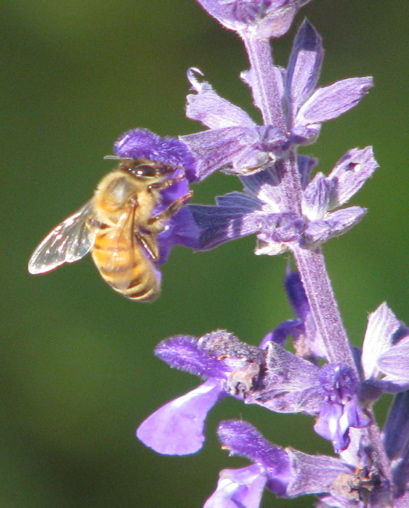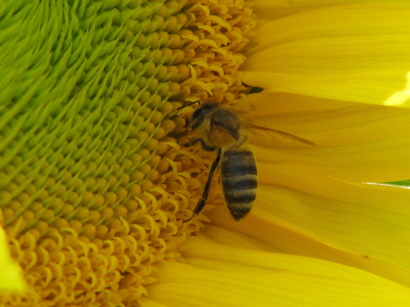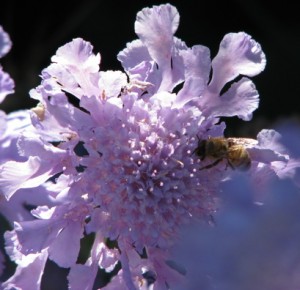Posts Tagged ‘Fruitless Fall’

I know I’ve been singing this song for a long time, y’all, but it’s bad, bad, bad and getting worse.
Soaring Bee Deaths in 2012 Sound Alarm on Malady – NYTimes.com
“They looked so healthy last spring,” said Bill Dahle, 50, who owns Big Sky Honey in Fairview, Mont. “We were so proud of them. Then, about the first of September, they started to fall on their face, to die like crazy. We’ve been doing this 30 years, and we’ve never experienced this kind of loss before.”
When beekeepers and scientists first starting investigating colony collapse disorder, causes were uncertain. Rowan Jacobsen’s excellent book, Fruitless Fall, explores possible reasons. (Here’s one of my many posts about the book.)
Five years later, we have a much clearer idea of exactly what is happening, and it’s very bad news.
But many beekeepers suspect the biggest culprit is the growing soup of pesticides, fungicides and herbicides that are used to control pests.
While each substance has been certified, there has been less study of their combined effects. Nor, many critics say, have scientists sufficiently studied the impact of neonicotinoids, the nicotine-derived pesticide that European regulators implicate in bee deaths.
The explosive growth of neonicotinoids since 2005 has roughly tracked rising bee deaths.
Neonics, as farmers call them, are applied in smaller doses than older pesticides. They are systemic pesticides, often embedded in seeds so that the plant itself carries the chemical that kills insects that feed on it.
The pesticide is embedded in the seeds. I posted to another piece on this topic this last week, and these are just a couple of the many anxious reports I’ve picked up on my bee wire (Google Alerts, when they’re working) in the past few months. I know I’m probably preaching to the choir here, but I implore you to read up on this issue, if you haven’t yet, and to spread the word far and wide. If we lose the bees, we lose the world as we know it.
(Poetry Friday visitors, Miss Dickinson awaits you at the bottom of the post.)
I mentioned I’ve become hooked on beekeeping blogs ever since reading Fruitless Fall. Here are a few of my favorites:
Hive Mind Bee Blog. A backyard beekeeper in Washington. I especially enjoyed his account of a swarm in his neighborhood:
When they’re flying in the air, there’s nothing you can do but watch, but when the queen lands, the rest of the swarm will land around her in a huge, sedate clump that you can put into a bucket or a box and put back into a hive. Julie made a quick call to Dawn of the Puget Sound Beekeeper’s Association, got some info on how to proceed, and we were back in business. I threw on some overalls and my bee shirt, grabbed a bucket and a spatula, and I’s ready for action. First, though, I stopped off at the school across the street where kids and parents were doing landscaping and upkeep on the grounds and let them know that we had a science fair moment, if they were interested. A couple of the moms gathered up a dozen or so 5 – 10 yr olds and they all trooped over to see the bees.
Honey Run Apiaries. Great pictures, thoughtful discussion, wry observations.
I recently read an 1858 book ‘Phelps Bee-Keeper’s Chart‘. The book is obviously horribly out of date and out of print (though it is available on-line). Though it is interesting none-the-less for several reasons. While it does cover a lot about honey bees, much of it is for the purpose of promoting the authors patented ‘Ohio Combination Bee-Hive‘ saying that he expects it to ‘ supersede all others’. Sadly, while it apparently claimed honors at the Ohio and other state fairs, his book was published 6 years after Lorenzo Lorraine Langstroth’s book ‘The Hive and the Honey Bee’, which details the bee hive most of us use today in the US and in other parts of the world.
Fruitless Fall discussed the rise of the Langstroth hive, so that was a neat connection for us. Amusing tidbit at the bottom of that post:
The running joke is that if you ask 5 beekeepers in a room a question, you will receive 6 different answers. Apparently this is one of the oldest beekeeping jokes on record. Phelps wrote nearly 150 year ago that ‘there is scarcely any subject on which such a diversity of opinion exists, as on the form and size of bee-hives, and the general management of bees.’
Linda’s Bees might be my favorite beekeeping blog so far. She writes from Atlanta and posts the most incredible pictures, really informative shots that let you see the action inside a hive. Her hives have fun names like Bermuda and Mellona (the Roman goddess of bees). Excellent sidebar full of links we’re exploring as time permits.
We rented this NOVA film about bees: Tales from the Hive. The cinematography was fairly stunning. The corresponding website has video of the different bee dances and an interview with the filmmaker about how he managed the breathtaking closeup shots of bees in flight.
The next step was to find out how I could fly with the bees, because they are fast. I told myself, if I can’t fly with the bee, then the bee has to fly with me—that is, with the camera, directly in front of the lens. It was like the work at a clockmaker’s. We used a pair of tiny tweezers to form a wafer-thin wire. We then tied the bee up with this—very carefully, because we did not want to harm the bee, and we wanted to make sure it had the freedom to move its wings. A special kind of arrangement enabled us to fix the wire to the camera.
The film was made in 2000, before the beginning of bee colony collapse and I think possibly even before the massive varroa infestation that has crippled so many hives in recent years.
My dear daddy sent me some cool links:
How to make a house for mason bees
Pursuit of the perfect pollinator
(Thanks, Dad!)
Since today is Poetry Friday, let me leave you with a little Emily Dickinson.
The Bee
Like trains of cars on tracks of plush
I hear the level bee:
A jar across the flowers goes,
Their velvet masonry
Withstands until the sweet assault
Their chivalry consumes,
While she, victorious, tilts away
To vanquish other blooms.
Her feet are shod with gauze,
Her helmet is of gold;
Her breast, a single onyx
With chrysoprase, inlaid.
Her labor is a chant,
Her idleness a tune;
Oh, for a bee’s experience
Of clovers and of noon!


As you know, I’ve had bees on my mind for weeks. I keep talking about Fruitless Fall: The Collapse of the Honey Bee and the Coming Agricultural Crisis, the book about bee colony collapse written by my former grad-school classmate, Rowan Jacobsen.
How much have you read about bee colony collapse?
I knew the honeybee’s numbers were declining. I remember hearing the wacky cell phone theory several years back, and that was laughed out of the news, and since then I’ve just heard ominous mutterings now and then about the bees disappearing and nobody knows why.
But I didn’t know the half of it.
I didn’t know, for example, that nowadays U.S. beekeepers earn most of their income—far more than they earn selling honey—trucking their hives around the country to pollinate crops. Somehow this gobsmacks me. We are dependent on migrant worker bees for the produce we grow in this country.


I definitely didn’t know that in the winter of 2006/2007, huge numbers of these hives began to die, and no one is sure exactly why. There are theories, which is a lot of what Rowan’s book is about: an in-depth and thoughtful exploration of what could possibly be causing the collapse of our bee colonies.
As I said above, when I heard about “the disappearance of the honeybee” I thought it meant declining numbers. Pesticides, I assumed (and indeed that seems to be a major factor). What I didn’t get was that bees literally disappeared. The hives died because the forager bees flew out and didn’t fly back home. There are diseases and pests that kill bees, and you find dead bees in and around the hive. (That’s happening too, in horrifying numbers.) But in other cases, the bees just up and disappeared. One possible explanation, Rowan learned, is a kind of disorientation and memory loss known to be a symptom of neurological damage caused by certain pesticides. It’s possible the bees are suffering from something like bee Alzheimer’s due to exposure to toxins meant to kill other insects. They fly off to work and can’t find their way back home. And in other hives, there are bees carrying every bee disease, fungus, and pest known to afflict the honeybee world—all at once. It’s as if their immune systems have been decimated (possible cause: the catastrophic wave of varroa mite infestation that arrived in this country a few years back and is a terrible scourge in many parts of the world right now), leaving them susceptible to other illnesses.
And it isn’t just the honeybees: we know a lot about the decline in their numbers because they are domesticated bees, owned by devoted beekeepers who know exactly how many hives they have lost to varroa and bee colony collapse. No one has good numbers on all the other pollinating insects out there, except it seems clear honeybees aren’t the only pollinators in decline. Did you know vanilla beans are hand-pollinated by humans? The insect pollinator has been wiped out.
 Obviously Fruitless Fall made a big impact on me. Shook me up; Jane too. The funny thing is, at the very same time that it was scaring the pants off me (a world short on pollinators is a scary, scary concept), it was filling me with wonder and delight. I know that sounds impossible. It’s the way Rowan looks so closely, with humor, warmth, and affection, at this ordinary (extraordinary!) creature, the honeybee. It reminded me of the John Stilgoe book I kept raving about last year, Outside Lies Magic. Remember that one? What Stilgoe did for me with power lines and telephone poles, Rowan Jacobsen did for me with bees and honey and even figs. The early chapters describing life in a beehive and the life cycle of the bee were so engaging that I read them aloud to 8-year-old Beanie, who was captivated. Jane (almost 14) has read the book at least three times now. She begged me to order Rowan’s book on chocolate—along with our very own copy of Fruitless Fall. Which is a good thing, because I find myself wanting to thrust the book at everyone I talk to. It’s that kind of book.
Obviously Fruitless Fall made a big impact on me. Shook me up; Jane too. The funny thing is, at the very same time that it was scaring the pants off me (a world short on pollinators is a scary, scary concept), it was filling me with wonder and delight. I know that sounds impossible. It’s the way Rowan looks so closely, with humor, warmth, and affection, at this ordinary (extraordinary!) creature, the honeybee. It reminded me of the John Stilgoe book I kept raving about last year, Outside Lies Magic. Remember that one? What Stilgoe did for me with power lines and telephone poles, Rowan Jacobsen did for me with bees and honey and even figs. The early chapters describing life in a beehive and the life cycle of the bee were so engaging that I read them aloud to 8-year-old Beanie, who was captivated. Jane (almost 14) has read the book at least three times now. She begged me to order Rowan’s book on chocolate—along with our very own copy of Fruitless Fall. Which is a good thing, because I find myself wanting to thrust the book at everyone I talk to. It’s that kind of book.
I stood in the garden for a long while this afternoon, watching a carpenter bee patrol the salvia. He was bigger than the blossoms and seemed black all over; maybe it was the light but I didn’t see any yellow on him. He inspected the bougainvillea and rejected it; same with the daisies. But the salvia pleased him. I counted how long he sipped at each small blossom: one, two, three—quick as that, no Mississippis.
Then the hummingbirds began to chitter and scold from the tops of the neighbor’s pepper trees. They’re like squirrels, a bit cheeky, a bit cross. They live in a different tree, the one just behind our back fence. I don’t yet know what kind it is. Its ferny green leaves are obscured by fat orange pollen strands these days, so that the tree looks a little like autumn, all out of place in the springy garden.
I wanted to see more bees: bumble bees, honey bees. I’m deep into Fruitless Fall; it’s a nailbiter, I must say. Jane pinched it from me yesterday and stayed up late reading. This morning when she came out for breakfast, she was reading as she walked down the hall. “You look troubled,” I said, and she said, “I am. This book.” She finished it by lunchtime and now she wants to keep bees. That’s not an option where we live right now, but maybe someday. I noticed she was rereading the book later this afternoon. It’s that kind of book. I plan to get my hands back on it tomorrow.
In the garden, ants were streaming up and down the sunflowers. I tried to see what they were up to, but the baby was falling asleep in the sling just then and I had to keep moving. A dragonfly buzzed my head and lit on one of our beanpoles: breathtaking creature. Its cellophane wings seemed threaded and edged with copper wire. It liked that perch on top of the pole. Five times it flew away and returned to the same spot. I went in for the camera and it was still there, sunning, the gypsy breeze blowing its wings a little the wrong way, backward toward the huge fly eyes. The copper wings gleamed. It looked like a piece of jewelry, not a live thing—and there it went, sailing over the wall.
You’re a figment of my imagination, I thought, a fairy. But the camera says otherwise. Still, I know what I know.

April 27, 2009 @ 8:23 pm | Filed under:
Books Don’t you wish reading and sleeping could be two completely interchangeable activities as far as our bodies’ well-being is concerned? If, instead of sleeping for six or seven hours, you could sleep for three hours and read for four, and be just as refreshed and healthy as if you’d slept all night?
That’d be cool.
Scott brought me home another winner from the library on Saturday, increasing my so-many-books-so-little-time torment. I’m still reading Gilead, ever so slowly, savoring the syllables, the quiet depths. But now I’m also reading—gulping—Fruitless Fall: The Collapse of the Honey Bee and the Coming Agricultural Crisis. This fascinating and rather terrifying work of nonfiction was written by a grad-school classmate of mine, Rowan Jacobsen. I think Jane will want to read it next. I’m loving Rowan’s conversational-but-smart prose. I’m chewing my nails off over the disappearance of the bees. Shortly after I started the book, I told Scott: “I expected this book to alarm me. I didn’t know it would scare the pants off me. By page two.”
Lots of quotes and thoughts to come, I’m sure. This is the kind of book that sticks with you (no honey puns intended).
I also had to squeeze in another Agatha Christie, at Jane’s request. She wanted to discuss something about the book’s conclusion, a plot point which was bugging her. Elephants Can Remember was one of Christie’s later books, I believe—at least, it takes place in the 1970s. A Poirot mystery, but not one of her best. And Jane’s question? Had to do with a massive flaw in the plot, one which I didn’t notice until she pointed it out. That’s my girl.





 Obviously Fruitless Fall made a big impact on me. Shook me up; Jane too. The funny thing is, at the very same time that it was scaring the pants off me (a world short on pollinators is a scary, scary concept), it was filling me with wonder and delight. I know that sounds impossible. It’s the way Rowan looks so closely, with humor, warmth, and affection, at this ordinary (extraordinary!) creature, the honeybee. It reminded me of the John Stilgoe book I kept raving about last year,
Obviously Fruitless Fall made a big impact on me. Shook me up; Jane too. The funny thing is, at the very same time that it was scaring the pants off me (a world short on pollinators is a scary, scary concept), it was filling me with wonder and delight. I know that sounds impossible. It’s the way Rowan looks so closely, with humor, warmth, and affection, at this ordinary (extraordinary!) creature, the honeybee. It reminded me of the John Stilgoe book I kept raving about last year, 